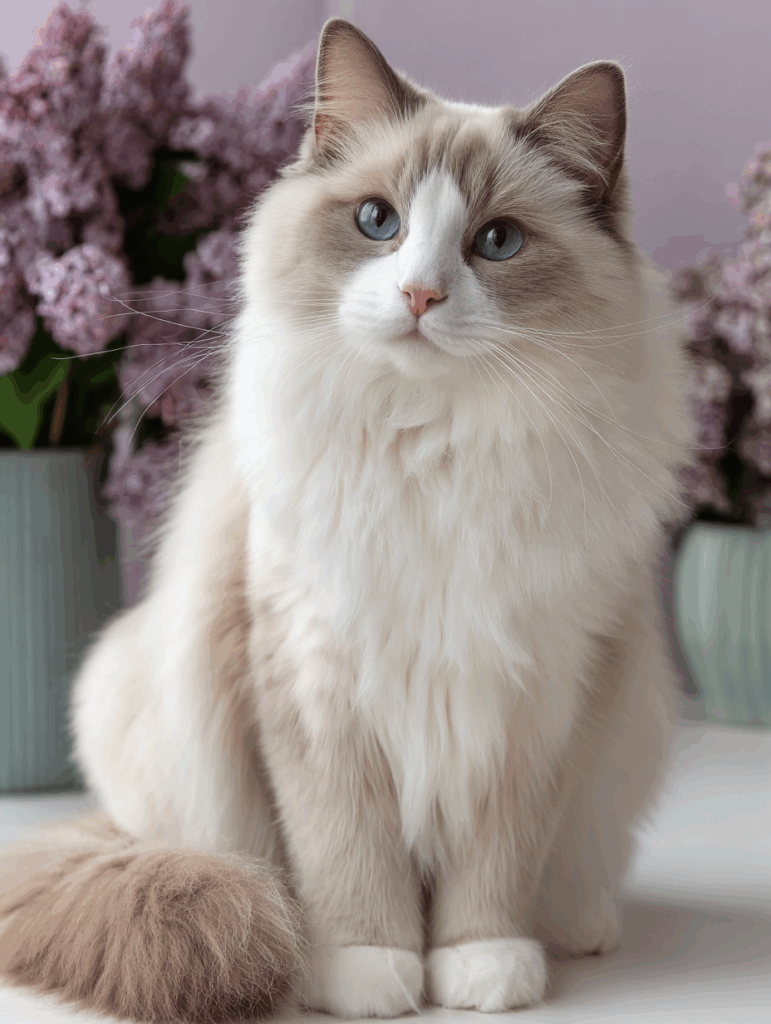
Meet the Lilac Point Ragdoll Cat
What Is a Lilac Point Ragdoll?
The Lilac Point Ragdoll is the lightest and rarest of all Ragdoll color variations. Despite the name “lilac,” the coat does not appear purple — it’s a soft, frosted mix of ivory and pinkish-gray, giving the cat an ethereal, porcelain look. The points (ears, tail, and face) are a diluted version of chocolate, creating a subtle contrast against a cool white body.
Lilac Point Ragdolls are officially recognized by both TICA and CFA, and their color is produced by the dilute gene, which softens darker pigments. In genetics, this color is known as chocolate dilute — meaning both parents must carry the recessive gene to produce a lilac kitten.
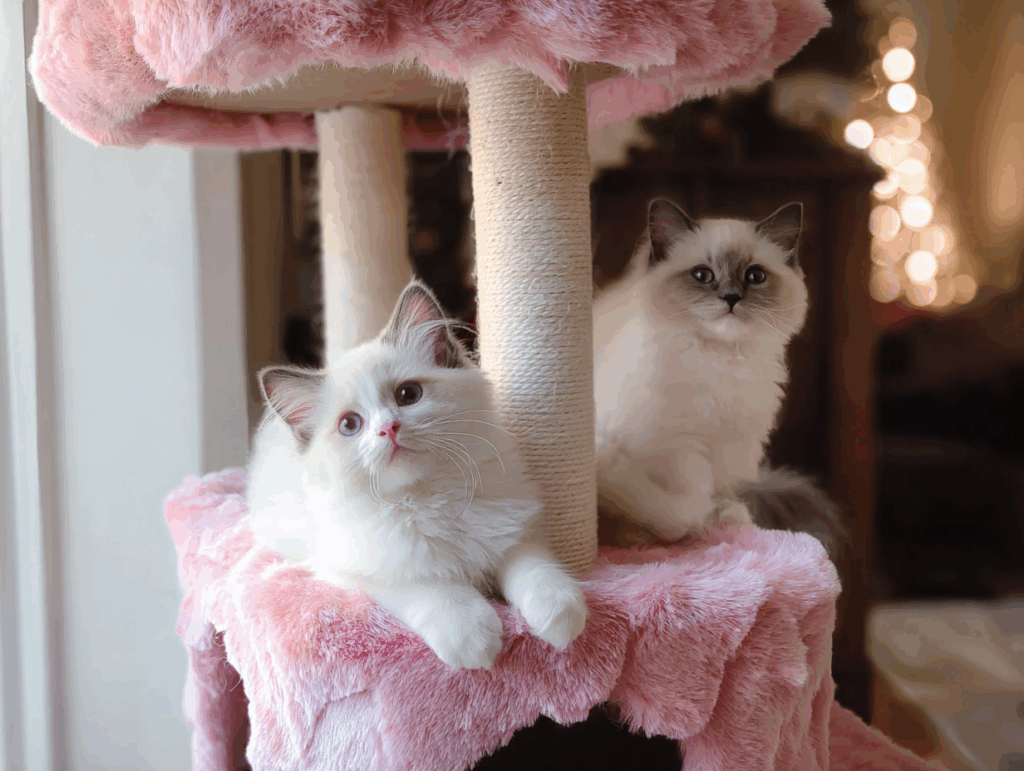
Lilac Point Ragdoll Kittens for Sale
Almonte Cats offers Lilac Point Ragdoll kittens for sale from health-tested, pedigree lines registered with TICA and CFA.
Our breeding program focuses on correct Ragdoll type, solid health, and consistent temperament. Every kitten is raised in-home, handled daily, and exposed to normal household life to prepare them for easy adjustment in their new homes.
Lilac Ragdolls are a rare genetic color created by combining the chocolate base gene with the dilute gene. Because this combination is recessive, Lilac kittens are only available in limited numbers each year.
How Our Lilac Point Ragdoll Kittens Are Raised
Our Lilac Point Ragdoll kittens are raised in a controlled, quiet home environment to encourage calm, confident behavior. Early socialization begins from birth and includes:
- Daily handling and human contact
- Exposure to grooming tools, nail trimming, and basic care routines
- Play sessions with age-appropriate enrichment
- Gradual introduction to children, other cats, and small dogs
This process ensures your kitten is well-socialized and ready for family life before going home.
Health, Testing, and Registration
Each kitten is bred from DNA-tested Ragdoll parents that meet or exceed TICA and CFA health standards. Before leaving for their new home, every Lilac Ragdoll kitten:
- Is examined by a licensed veterinarian
- Receives core vaccinations appropriate for age
- Is microchipped and dewormed
- Comes with an official TICA or CFA registration
- Includes a written health guarantee for congenital conditions
All breeding cats in our program are tested for Hypertrophic Cardiomyopathy (HCM) and Polycystic Kidney Disease (PKD) through UC Davis Veterinary Genetics Laboratory or equivalent accredited labs.
Why People Love Lilac Point Ragdoll Kittens
Lilac Point Ragdolls have a lighter look then the seal point kittens. They look more ethereal. They are gentle, quiet, and people-oriented. Because the lilac color is one of the lightest and rarest recognized Ragdoll color, these kittens are in high demand among buyers who appreciate quality and authenticity.
Families choose Almonte Cats for:
- Verified TICA/CFA registration
- Proven health-tested parents
- Limited litters focused on temperament and color accuracy
- Transparent communication and lifetime breeder support
Lilac Ragdoll Kitten Availability and Reservation
Due to limited production, we accept a small number of approved reservations each season.
Approved applicants may place a non-refundable reservation deposit to hold a kitten or join the Kitten Waitlist for upcoming litters.
Before pickup, we arrange a virtual video call so families can meet their kitten and confirm selection. Kittens go home with:
- Medical and vaccination records
- Starter food and care guide
- A blanket with familiar scent to ease transition
Nationwide Delivery Options
We provide safe, USDA-compliant delivery options through licensed pet transporters or in-cabin flight nannies. Kittens can be hand-delivered across the United States, including to major airports in New York, California, Texas, and Florida.
Reserve a Lilac Point Ragdoll Kitten
Because Lilac Point Ragdoll kittens are available in very small numbers each year, early reservation is strongly recommended.
👉 Apply for a kitten or view our available kittens
Lilac Point Ragdoll Appearance
- Body Color: Frosty white or magnolia
- Points: Pinkish-beige, light taupe, or soft dove-gray
- Eyes: Deep blue, ranging from sapphire to icy aqua
- Nose & Paw Pads: Lavender-pink
- Coat Texture: Silky, medium-long, low-matting coat typical of all Ragdolls
The Lilac Point Ragdolls are often compared to Blue Points, but the difference becomes clear side-by-side: Blue Points have a colder tone, while Lilac Points carry a slightly lighter and warmer shade.
Lilac Point vs. Other Ragdoll Colors
| Color | Point Shade | Body Tone | Rarity |
|---|---|---|---|
| Seal Point | Deep brown | Cream | Common |
| Blue Point | Slate gray | Icy white | Common |
| Chocolate Point | Milk chocolate | Ivory | Uncommon |
| Lilac Point | Pinkish gray | Magnolia | Rare |
| Flame Point | Apricot or orange | Cream | Rare |
Lilac Points are prized among collectors and breeders for their delicate pastel glow and the fact that the color line can be difficult to maintain. Their rarity makes them one of the most sought-after variations for families who want something uncommon but still true to the Ragdoll’s classic temperament.
Related Ragdoll Color Posts
- Blue Point Ragdoll Cats – Discover how their slate-gray points and icy tone differ from lilac.
- Seal Point Ragdoll Cats – The traditional Ragdoll color with rich chocolate-brown points and deep contrast.
- Chocolate Point Ragdoll Cats – Learn how warm ivory coats and milk-chocolate points create this soft mid-tone look.
- Flame Point Ragdoll Cats – See how orange appears in Ragdoll Genetics.
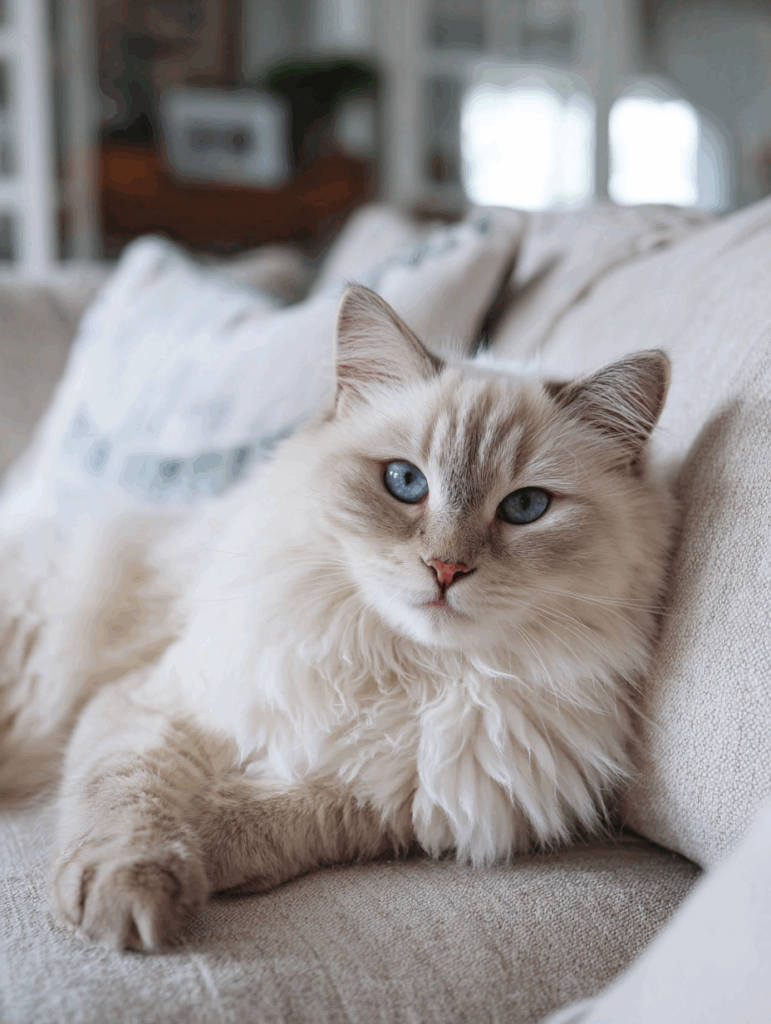
Lilac Ragdoll Genetics
Understanding the B Locus
The soft lilac coloring begins at the B locus, the gene responsible for determining the depth of pigment in a cat’s coat.
Ragdolls that express the dominant B allele develop darker, seal-toned points, while those carrying the recessive b allele display lighter shades — such as chocolate or lilac.
Here’s how it breaks down:
- B (Black) – Dominant; produces deep colors like seal or blue points.
- b (Brown/Chocolate) – Recessive; lightens the base pigment and is necessary for both chocolate and lilac cats.
To produce a true Lilac Ragdoll, both parents must contribute the recessive b gene, giving the kitten a bb genetic foundation. This means the kitten is technically chocolate-based at the DNA level, even though the coat will appear much paler — soft ivory with pinkish-gray points.
The Role of the Dilute Gene
Color dilution happens through another gene entirely — the D locus. This one determines whether a cat’s color will appear bold and saturated or light and powdery.
- D (Dense) – Dominant; keeps the color rich, as in seal or chocolate points.
- d (Dilute) – Recessive; mutes the pigment, creating lighter tones like blue or lilac.
Only when a kitten inherits two dilute genes (dd) will the color appear softened. So when a kitten’s genetic makeup is bbdd — chocolate base combined with dilution — the result is the delicate lilac hue seen in this variety of Ragdoll.
Why Lilac Ragdolls Are So Rare
Because both the chocolate and dilute traits are recessive, the combination bbdd is uncommon. Both parents must carry two copies of each recessive gene for the lilac color to appear in their offspring. Even with precise pairings, genetics can still surprise you — producing blue, chocolate, or seal kittens instead of lilac.
This is why Lilac Point Ragdolls remain one of the rarest traditional color variations. Breeders dedicated to this shade often plan matings several generations ahead, pairing carriers with verified DNA profiles to maintain health and color accuracy.
Producing lilacs isn’t just about color — it’s about protecting genetic diversity and ensuring that each kitten retains the true Ragdoll temperament and structure the breed is known for.
Share Your Lilac Ragdoll
Are you the proud owner of a Lilac or other rare-colored Ragdoll? We’d love to include your cat as a real-life example in our upcoming color guide series.
📸 Submit a clear, well-lit photo of your Ragdoll to help others learn more about these stunning variations. Click here to share your cat!

Personality and Temperament
Like all Ragdolls, Lilac Points are gentle, affectionate, and people-focused. They tend to follow their owners from room to room and adapt easily to household routines.
Typical Lilac Point traits include:
- Calm and affectionate disposition
- Excellent tolerance for children and other pets
- Strong attachment to their family
- A tendency to “flop” when held (the classic Ragdoll trait)
They are not high-energy cats, but they enjoy interactive play sessions and thrive in homes where they receive daily attention.
Grooming and Care
Despite their luxurious coats, Lilac Ragdolls are low-maintenance compared to other long-haired breeds.
- Brush 2–3 times per week to prevent tangles.
- Bathe occasionally if needed, but overbathing can dull the natural sheen.
- Keep nails trimmed and eyes gently cleaned to remove tear staining (more visible on lighter coats).
Feed a high-quality diet with balanced omega fatty acids to maintain coat shine and skin health.
Health and Longevity
Lilac Point Ragdolls live 12–16 years on average when well cared for. Responsible breeders test for:
- Hypertrophic Cardiomyopathy (HCM)
- Polycystic Kidney Disease (PKD)
- FIV/FeLV negative status
Routine veterinary visits and weight management are key — like most Ragdolls, Lilac Points can become overweight if under-exercised.
Are Lilac Point Ragdolls Rare?
Yes. Lilac is one of the rarest colorations because it requires both parents to carry dilute genes. This makes them more exclusive and often higher priced than other colors. Many breeders produce lilac kittens only a few times a year, making early reservations essential for serious buyers.
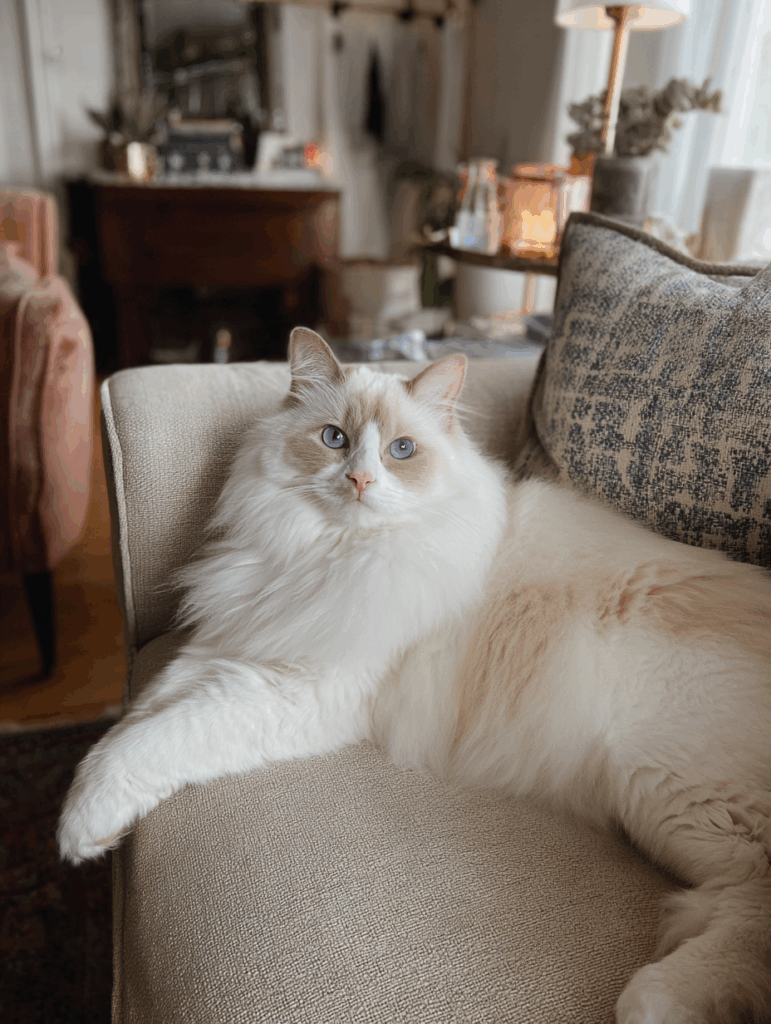
FAQ about Lilac Ragdoll Cats
Are Lilac Point Ragdolls rare?
Yes. Lilac Point Ragdolls are one of the rarest color variations in the breed. The lilac tone comes from a double recessive genetic combination — chocolate base plus the dilute gene. Both parents must carry these genes, which makes producing true lilac kittens uncommon. Breeders often plan litters several generations in advance to achieve this color.
Learn more about how color genetics work in our Ragdoll Genetics section.
What does a Lilac Point Ragdoll look like?
Lilac Points have a frosty white or magnolia body with soft pinkish-gray points on the face, ears, tail, and paws. Their paw pads and nose leather are lavender-pink, and their eyes are deep sapphire blue. They often appear lighter and softer than Blue Points, with a more pastel glow.
Compare colors in our Blue Mitted Ragdoll Post
Is a Lilac Ragdoll the same as a Lavender Ragdoll?
Yes — “lilac” and “lavender” describe the same genetic color. Some breeders use “lavender” because it better conveys the pink-gray tone, but “lilac” is the correct registry term used by TICA and CFA.
Are Lilac Point Ragdolls born white?
All pointed Ragdolls, including lilacs, are born completely white. Their color develops slowly over the first 8–12 weeks of life as temperature-sensitive pigmentation appears on the cooler parts of the body.
Do Lilac Ragdolls change color as they grow?
Yes, slightly. Their points darken gradually with age, and the body tone may warm from ivory to magnolia. However, they will always remain the palest color variety in the Ragdoll spectrum. Exposure to cooler temperatures can also intensify point color slightly.
What is the difference between Lilac Point and Blue Point Ragdolls?
Both are diluted colors, but Lilac is the lighter and warmer of the two.
- Lilac Point: pink-gray points, magnolia body, lavender-pink nose.
- Blue Point: slate-gray points, icy-white body, blue-gray nose.
Lilacs carry chocolate-based genetics, while Blues are seal-based.
Do Lilac Point Ragdolls have pink noses?
Not bright pink — more of a soft lavender-pink or mauve shade. This subtle coloring is one of their signature features.
What color eyes do Lilac Ragdolls have?
Like all Ragdolls, they have striking blue eyes. The shade can range from light aqua to deep sapphire, depending on the line. Eye color tends to intensify with maturity and is most vivid in strong natural light.
Are Lilac Point Ragdolls purebred?
Yes. Lilac is an officially recognized color by major cat registries such as TICA, CFA, and ACFA. True Lilac Ragdolls are registered purebreds, not crossbreeds.
If you see “rare lilac mix” or “lavender Ragdoll” without registration paperwork, it may not be a purebred cat.
How much does a Lilac Point Ragdoll cost?
Expect to pay between $3,500–$5,000+ from a reputable breeder. Price depends on pedigree, markings, eye color, and whether the kitten is sold as a pet or with breeding rights. Because lilacs are rare, most breeders produce them in limited numbers each year.
View our Available Ragdoll Kittens for Sale page for current litters.
Do Lilac Ragdolls need special grooming?
No — their coat requires the same care as any Ragdoll. Brush 2–3 times per week to remove loose hair and prevent tangles. They rarely mat and do not have a heavy undercoat. Occasional bathing helps maintain their pale coat color.
Do Lilac Ragdolls shed a lot?
Moderately. They shed seasonally but much less than Persians or long-haired domestic cats. Regular brushing keeps shedding under control and maintains coat texture.
What is the temperament of a Lilac Point Ragdoll?
Lilac Points are affectionate, calm, and people-focused. They enjoy being held, following family members, and lounging near their favorite person. They adapt easily to children and other pets, making them ideal companions for families or quiet households.
Are Lilac Ragdolls good with dogs or other pets?
Yes. Ragdolls are one of the most dog-friendly cat breeds. They adjust well to multi-pet homes, especially if introductions are gradual. Their gentle nature and tolerance make them excellent companions for calm dogs.
Are Lilac Point Ragdolls hypoallergenic?
No cat is truly hypoallergenic, but Ragdolls are often better tolerated by allergy sufferers because they lack a dense undercoat and shed less dander than other long-haired breeds. Regular brushing and air purification can help reduce allergens.
Read our Are Ragdoll Cats Hypoallergenic for grooming tips.
How long do Lilac Point Ragdolls live?
With good care, Lilac Ragdolls live 12–16 years, sometimes longer. Longevity depends on genetics, diet, and veterinary care.
See our Complete Guide to Ragdoll Cats for preventive tips.
What health issues are common in Lilac Ragdolls?
They share the same potential issues as all Ragdolls:
- Hypertrophic Cardiomyopathy (HCM)
- Polycystic Kidney Disease (PKD)
- Obesity from inactivity
Reputable breeders perform DNA screening and heart scans before breeding to reduce risks.
Are Lilac Ragdolls vocal or quiet?
Generally quiet, but they will “talk” softly when they want attention. Their voice is gentle — more of a coo or trill than a meow.
How big do Lilac Ragdolls get?
Adult males typically weigh 15–20 lbs, and females average 10–15 lbs. They mature slowly and may not reach full size until 3–4 years old. Their light color can make them appear smaller than darker Ragdolls, but they have the same solid build.
Learn more in our post When Do Ragdoll Cats Stop Growing?
What’s the best diet for a Lilac Ragdoll?
Feed a high-protein, moderate-fat diet formulated for large breeds. Avoid fillers and low-quality carbs that can dull the coat or cause weight gain.
Omega-3 and Omega-6 fatty acids support their pale coat’s shine and help maintain skin health.
Can Lilac Ragdolls go outside?
They should be kept indoors or in secure outdoor enclosures. Their gentle nature and lack of street smarts make them vulnerable to theft and danger. If you allow outdoor time, use a harness or supervised catio setup.
Do Lilac Ragdolls like water?
Many do! Ragdolls are often curious about water and may paw at running faucets or join you near the bath. They can be gently accustomed to bathing as kittens.
When do Lilac Ragdolls reach full color?
Most Ragdolls reach their full color intensity by 3 years old, though subtle shading changes can continue beyond that. Kittens may look nearly white for their first few months.
What colors can two Lilac Ragdolls produce?
Two Lilac parents can only produce Lilac kittens, since they carry only recessive genes (bbdd). However, if bred with a Chocolate or Blue carrier, they could produce a mix of Lilac, Chocolate, or Blue kittens.
Do Lilac Ragdolls make good emotional support pets?
Yes. Their calm, affectionate personality and intuitive nature make them excellent therapy or emotional support companions. They adapt easily to routines and are known for bonding deeply with one person.
Where can I buy a Lilac Point Ragdoll kitten?
Always choose a registered breeder who performs genetic testing, raises kittens in-home, and provides documentation. Avoid online ads or “rare color” claims without proof.
You can apply for a kitten or join our waiting list at Almonte Cats.
Resources & References
Breed Standards & Registries
- The International Cat Association (TICA) – Ragdoll Breed Standard
- Cat Fanciers’ Association (CFA) – Ragdoll Breed Profile
- American Cat Fanciers Association (ACFA) – Ragdoll Overview
Color Genetics & Coat Dilution
- UC Davis Veterinary Genetics Laboratory – Cat Coat Color Testing
- Basepaws – Feline Genetics and Color Inheritance
- Messybeast – Cat Genetics: Dilute and Chocolate Genes Explained
Health & Care
- Cornell Feline Health Center – Ragdoll Breed Health Information
- International Cat Care – Cat Life Stages
- PetMD – Ragdoll Cat: Breed Info, Health, and Temperament
From Almonte Cats
- Ragdoll Lynx Pattern
- Chocolate Point Ragdoll
- Flame Point Ragdoll
- How Big Do Ragdoll Cats Get
- Available Ragdoll Kittens for Sale
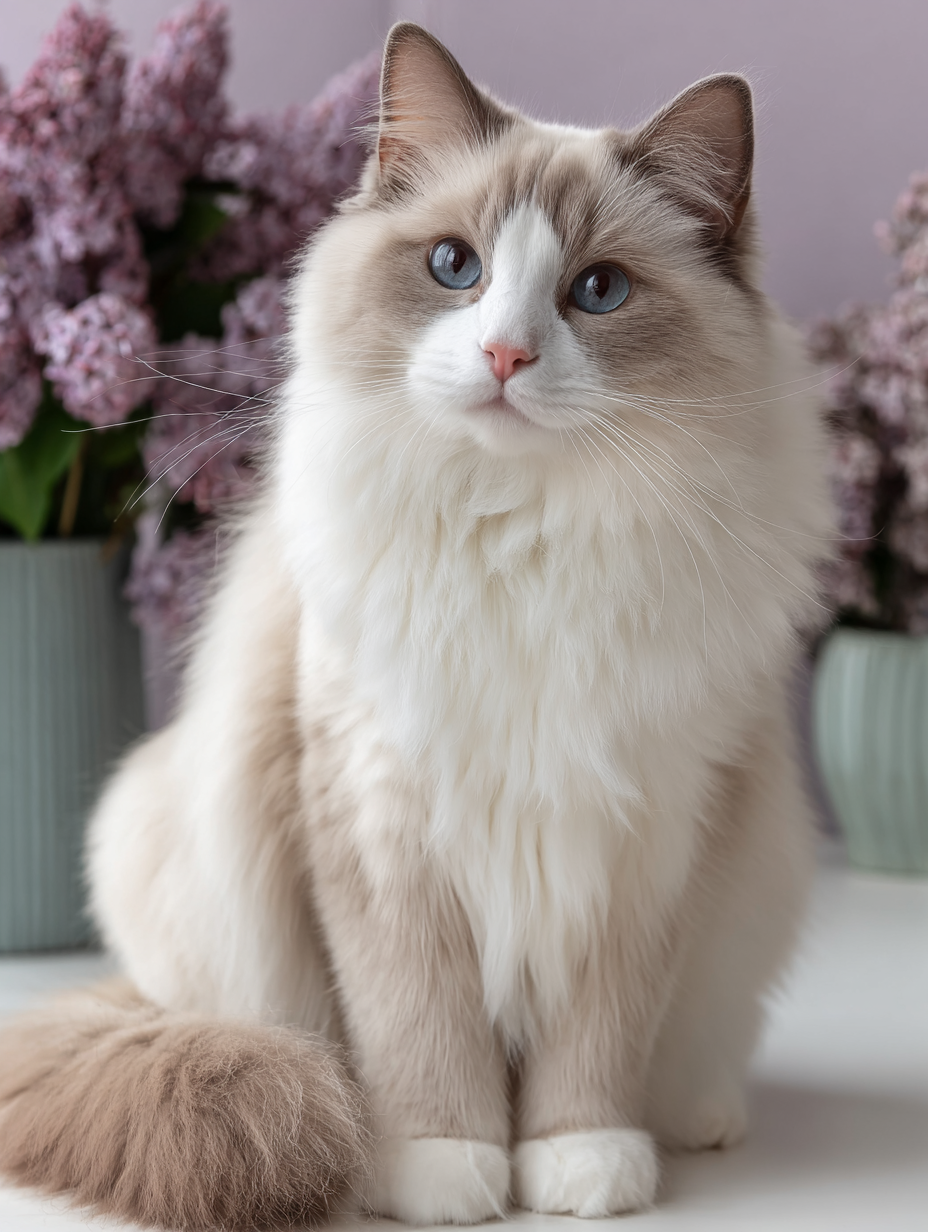
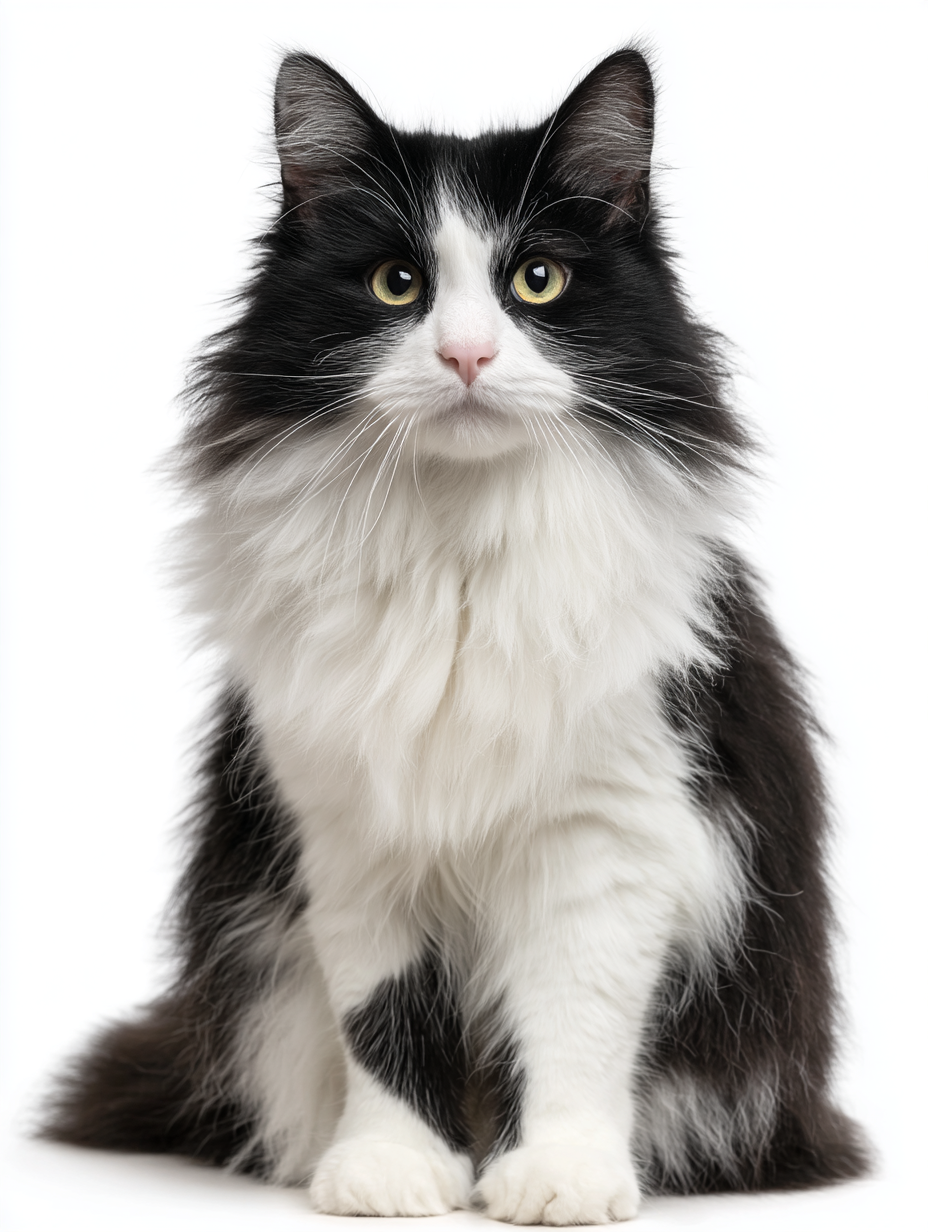
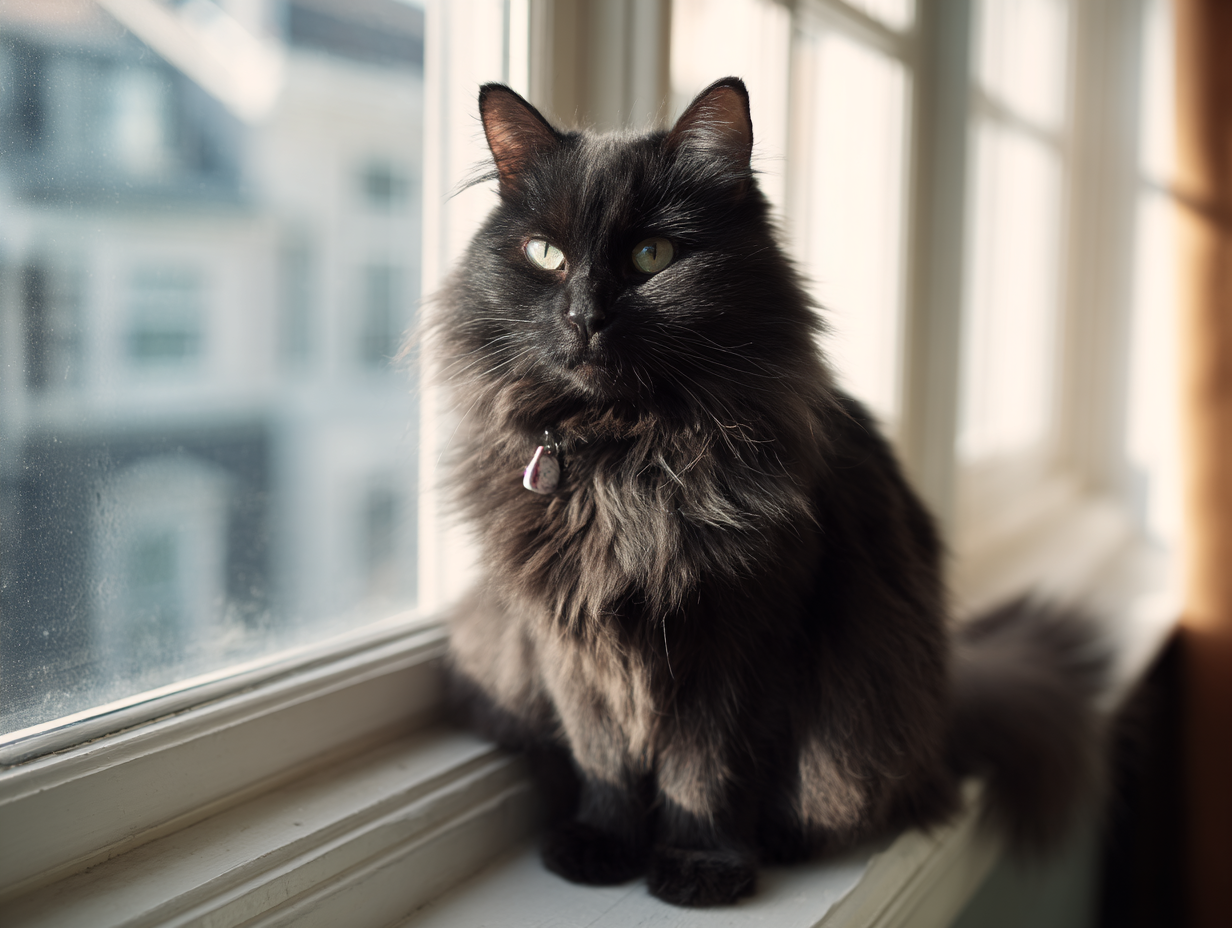
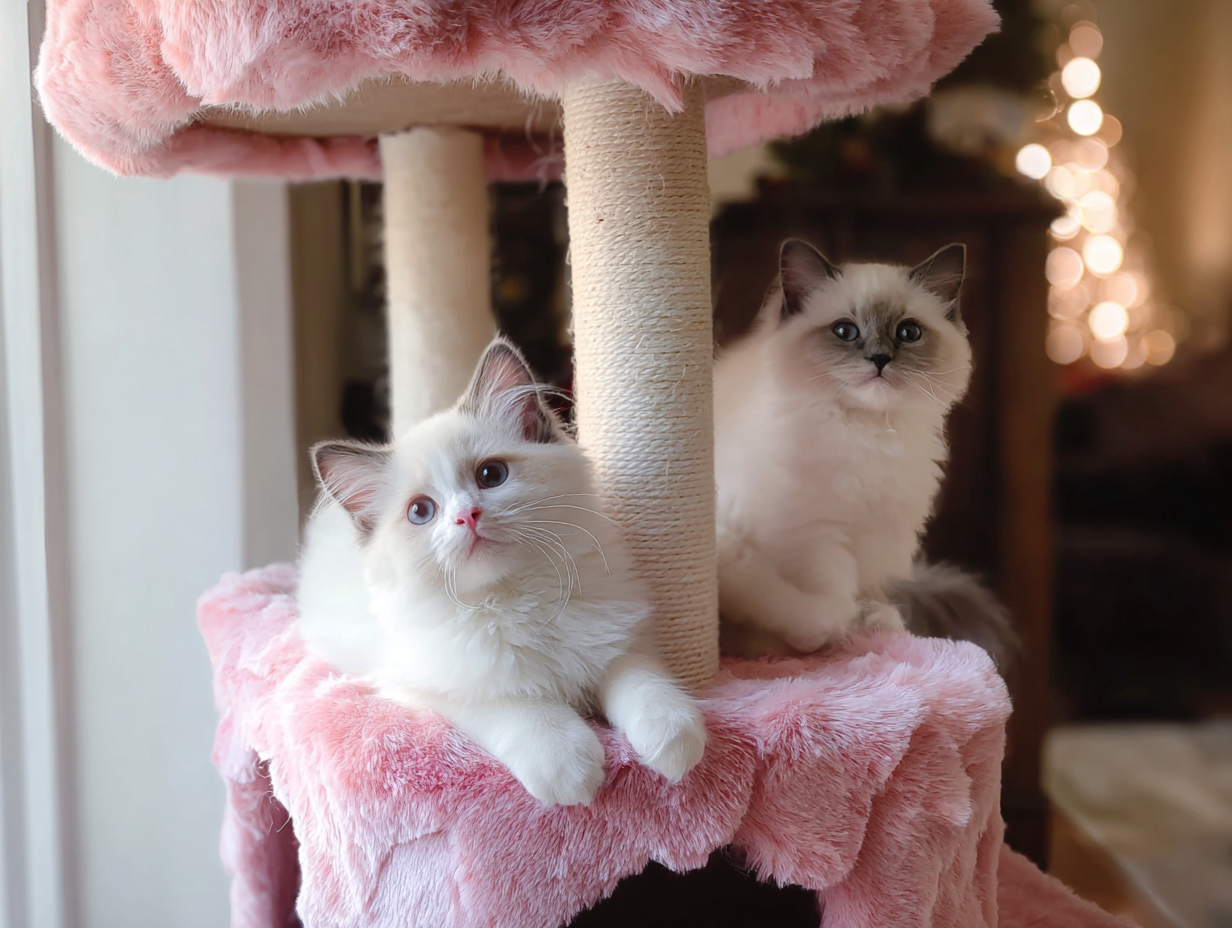
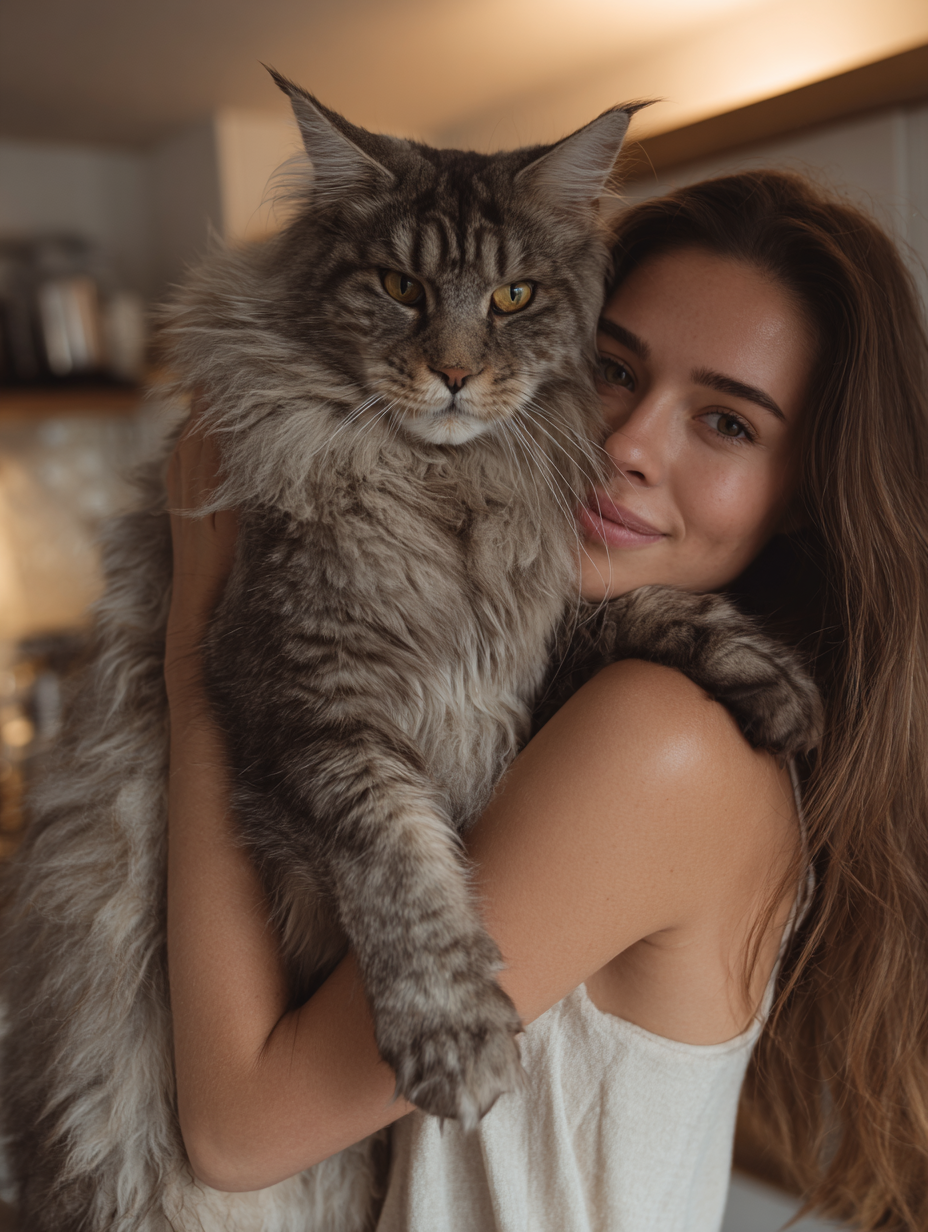

Read the Comments +